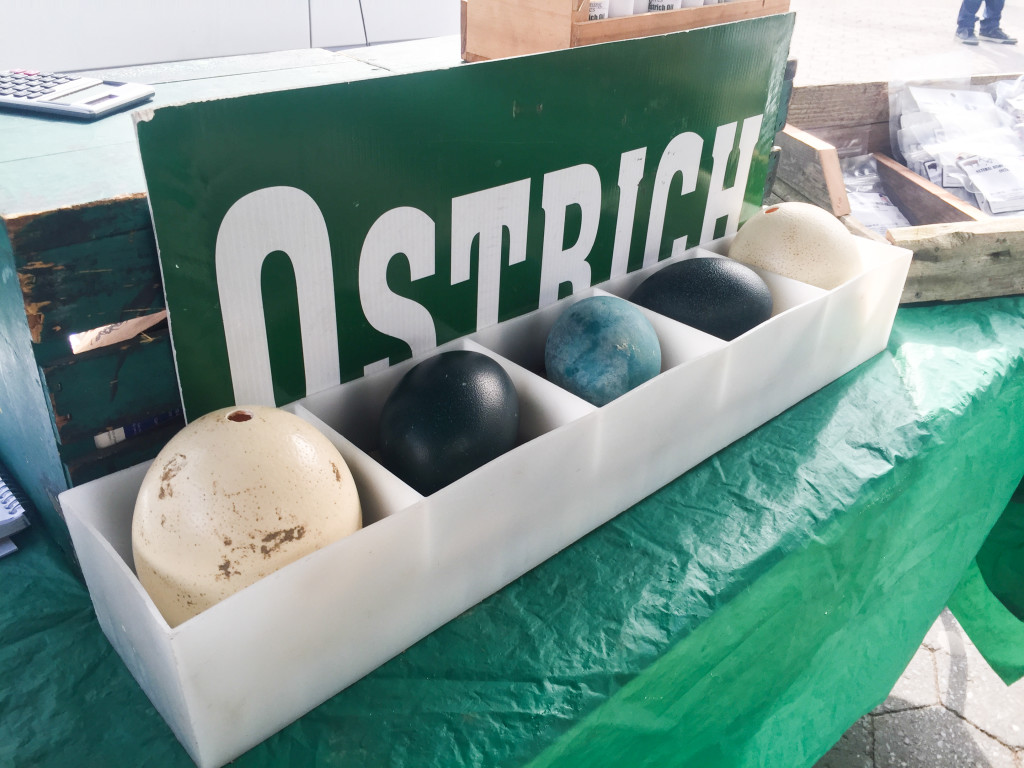
Ostrich and emu eggs draw customers in at the Roaming Acres stand. Photo: Aleksandra Konstantinovic.
At the Union Square Greenmarket, members of a second-grade class on a field trip clapped their hands over their cheeks and pointed in awe at the three-pound egg in Lou Braxton’s hands. The affable Roaming Farms frontman and purveyor of ostrich products played to his young audience with a few facts about his birds.
“An ostrich, when he’s born, is as big as a chicken. But by the time he’s a year old, he’s over six feet tall and weighs 200 pounds,” Braxton said, reaching a hand high over the transfixed eyes of the group.
If you’ve never been within pecking distance of an ostrich, you’ve made a good life choice. Aggressive and territorial, these birds have brains that are smaller than their eyes and take an immediate dislike of anyone in their space. According to Braxton, the big birds are also quite delicious.
Labeled a high-end, exotic product fetching up to $20 for an 8-ounce filet, ostrich isn’t exactly an American staple. But with a World Health Organization study warning that red meat, when cooked, is a “probable” cause for some kinds of cancer, ostrich could be the answer in a world that has a beef with beef.
With a curled mustache that would make Parks and Recreation’s Ron Swanson weep with jealousy, Braxton speaks as if to let you in on a secret: ostrich is in fact a red meat, but one that escaped the WHO warning because it doesn’t come from a mammal. It also happens to boast a recommendation from the American Heart Association for its low cholesterol, saturated fat and sodium. In other words, for all those who thought steak was permanently off the menu, it turns out that the steak just needs to come from an ostrich.
And the bird tastes just like beef, Braxton swears. Roaming Acres’ most popular product is a filet, but the meat is also made into burgers and a jerky; otherwise you’d be trying to bite into a 40-pound drumstick for dinner. Don’t cook the filet through though — it needs a little oil, a light sear and seasoning like a steak.
But for the skeptical crowd, some questions might remain: when exactly does one eat ostrich? Does it give turkeys a reprieve from Thanksgiving, or, as a red meat, is it more of a Christmas roast?
According to Braxton, the meat doesn’t see a spike around either holiday. In fact, in its 4,500-year history of cultivation, ostrich has never hit an astronomical high or low with consumers— except, Braxton recalls, a wild couple of years in the 70s when raising ostrich was considered a get-rich-quick scheme. Roaming Acres’ loyal customers come steadily year-round, as part of the health-conscious crowd that already shops at farmers’ markets.
While the WHO study was widely misinterpreted by alarmist headlines, traditional red meat has been linked to heart disease, high cholesterol and obesity. Nutritionist Natasha Uspensky said that ostrich, a lean meat like bison, is having a moment in the world of nutrition as more people agree there is a link between eating meat and illness.
“Ostrich is a smarter way to go when it comes to animal protein comparatively speaking,” she said, citing the nutritional content of ostrich versus beef. “But I still recommend to my clients to take it easy with meat.”
Uspensky said she’s seen a slight uptick in people concerned about eating traditional red meat since the WHO study was released, but that the information from that study has been around since the 2005 publication of “The China Study” by biochemist and nutrition advocate T. Colin Campbell and his son, Thomas M. Campbell.
But no matter the warnings, or how often they’ve been warned, there will always be a portion of people who don’t care to listen, Uspensky said.
“The meat lobby is so powerful. And as long as meat-heavy diets are cheaper than eating fresh, local produce, you won’t see much change,” she said. “Before ostrich, you had bison fighting industrial beef.”
One reason ostrich has never made it in the conventional sense is the price, which is a product of its exotic status. Up until a few years ago, even the U.S. Department of Agriculture wasn’t sure how to classify the ostrich, a red-meat bird that’s prized for both its leather and feathers. It became a problem for processors, Braxton said, who typically weren’t allowed to slaughter cows and pigs if ostriches — then a non-amenable species not regulated by the USDA— had passed through their facilities. At the same time, ostriches, classified as livestock, weren’t allowed in poultry slaughterhouses. The birds have since been reclassified as regular poultry, like chicken, and are slowly becoming more mainstream on the industry side as these regulations clear up. But the residual high cost of processing, coupled with the fact that there are so few farms raising the birds to begin with, keeps both demand and prices fairly high. That eight-ounce ostrich filet is nearly double the price of a similar beef cut at $10 to $15.
The average American consumes 50 pounds of beef every year, or 100 filets mignons each, representing a $44 billion industry. Even in South Africa, a leading exporter of ostrich, there’s no competition with the all-American love of cow parts: in 2011-12, consumers there ate just over 13 million pounds of ostrich in a $19 million dollar industry — or, about a quarter of a pound of ostrich meat per person.
South African ostrich producers rely on exports and sales of feathers and leather to keep up profits, according to the country’s department of agriculture. In that tradition, Roaming Farms also sells ostrich top-down, including bones as dog treats and lotion made of ostrich oil in case after trying your first filet, you feel the need to cover your home and body in ostrich too.

The Roaming Acres stand at the Union Square Greenmarket on Feb. 19 2016. Photo: Aleksandra Konstantinovic.
Ostrich bones are, in fact, the pet treats of choice for Roselie Maringoni, who brings her Instagram-famous pup Diesel to the Roaming Acres stand at Union Square all the time. Diesel used to chew regular pet-store variety bones, but now won’t have anything but ostrich — probably because Roaming Acres smokes their bones, Maringoni said.
“He’s ten years old and chewed so many ostrich bones, he has a front tooth that’s soft,” she said. “We took them away, but he begs for them, so today it’s a treat.”
As Faina Levitsky approached the Roaming Acres stand, she expressed the kind of surprise that many people do when considering ostrich as a food for the first time.
“I didn’t even think you could eat an ostrich!” Levitsky said. “I thought they were endangered.”
Chris Bellini, filling in for Braxton at the stand, assured Levitsky that ostriches are doing just fine. In fact, he tends to a flock numbering 200 at Roaming Acres.
Levitsky said she’d never seen ostriches sold at markets or restaurants before, but appreciates that the meat is organic and nitrate-free. And for someone completely new to the product, she made off well, with two filets and some ground ostrich.
As she was leaving, Levitsky pointed to one of the enormous eggs that had captivated the class before.
“That’s an emu egg? You can’t eat an emu egg,” she said to Bellini. “You can? That’s incredible.”
Tags: Farmers Market, Manhattan, ostrich, red meat, shopping, union square greenmarket
Your Comments